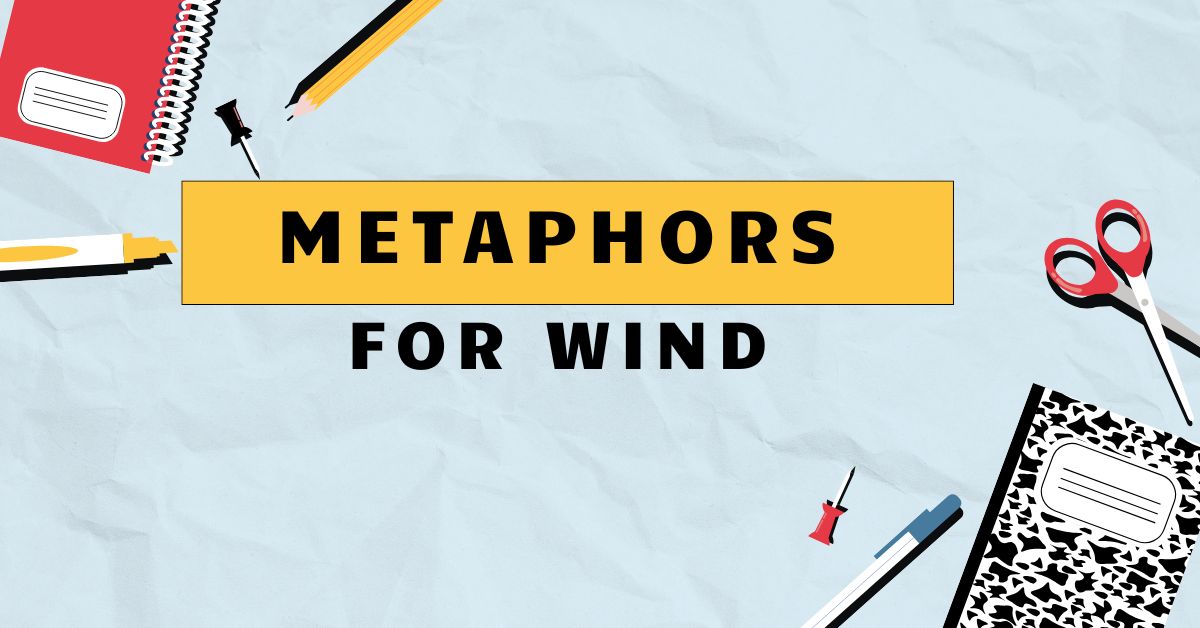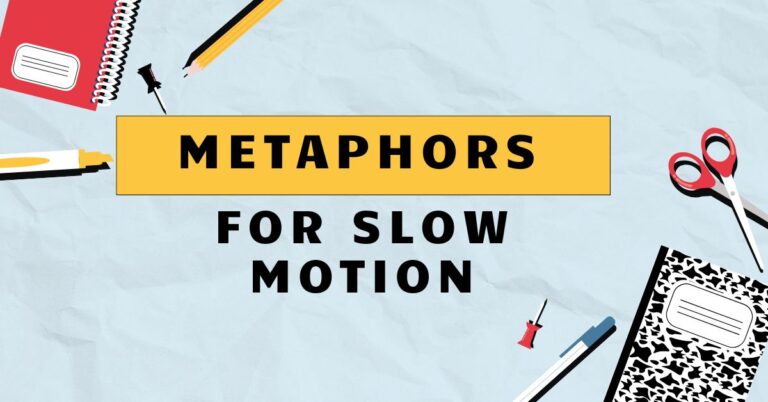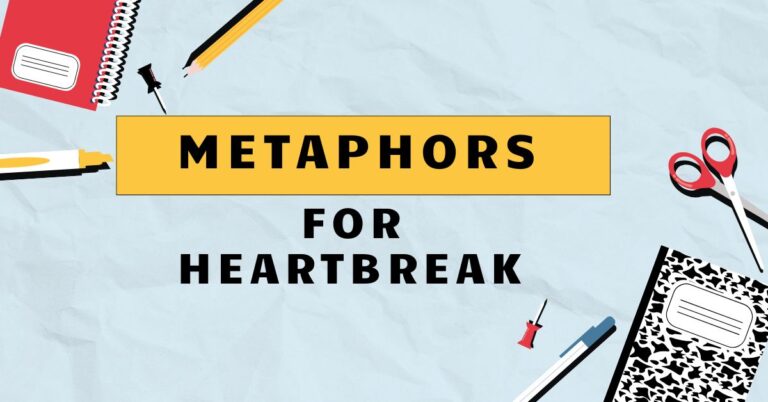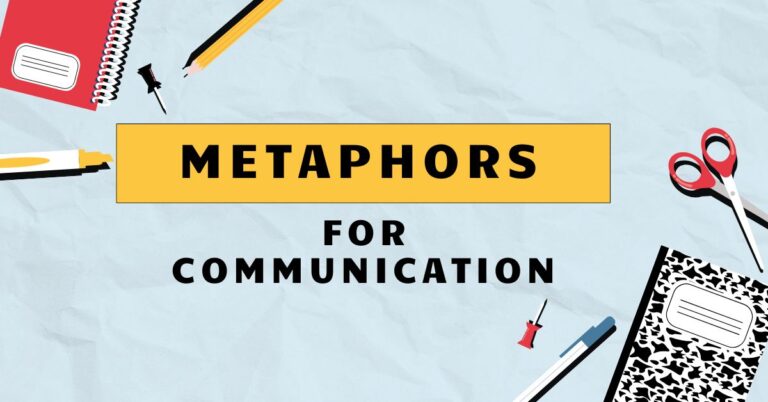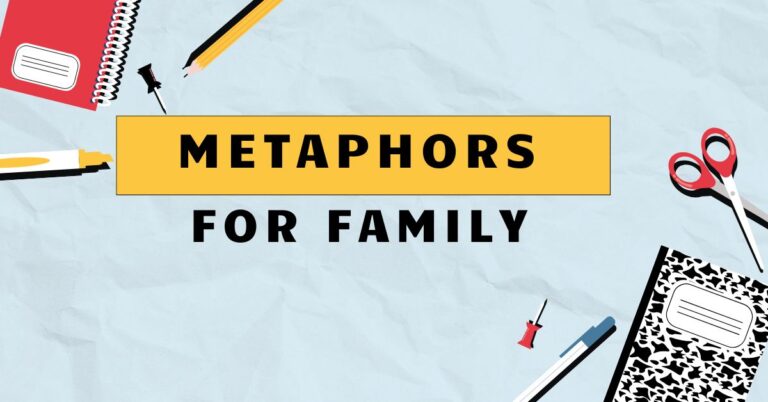41 Metaphors for Wind: A Comprehensive Guide to Figurative Language
Understanding metaphors is crucial for mastering English, as they enrich language, add depth to expression, and enhance comprehension. Metaphors allow us to understand one concept through the lens of another, creating vivid imagery and making abstract ideas more concrete.
This article explores the use of metaphors for “wind,” offering a detailed guide for English learners, writers, and anyone seeking to improve their command of figurative language. By examining various types of wind metaphors and providing ample examples, this guide will help you recognize, interpret, and effectively use metaphors in your own writing and speech.
Table of Contents
- Introduction
- Definition of Metaphor and Its Significance
- Structural Breakdown of Wind Metaphors
- Types of Wind Metaphors
- Examples of Wind Metaphors
- Usage Rules for Wind Metaphors
- Common Mistakes When Using Wind Metaphors
- Practice Exercises
- Advanced Topics in Wind Metaphors
- Frequently Asked Questions
- Conclusion
Definition of Metaphor and Its Significance
Ametaphoris a figure of speech that directly compares two unrelated things without using “like” or “as.” It asserts that one thingisanother, implying a similarity or shared quality. Metaphors are powerful tools in language because they create vivid imagery, convey complex ideas concisely, and engage the reader’s imagination.
Understanding metaphors is essential for interpreting literature, poetry, and everyday conversation, as they often add layers of meaning beyond the literal.
Metaphors function by transferring qualities from one concept (thesource domain) to another (thetarget domain). In the context of wind metaphors, “wind” is the target domain, and various other concepts serve as the source domain, such as voices, forces, or journeys.
This transfer of qualities allows us to perceive wind in new and imaginative ways, enriching our understanding and appreciation of its multifaceted nature.
Metaphors are used extensively in literature, poetry, and everyday speech to add color, depth, and emotional resonance to language. They allow writers and speakers to express abstract or complex ideas in a more accessible and engaging way.
For example, instead of simply stating that the wind is strong, a metaphor might describe it as a “roaring lion,” immediately conveying the wind’s power and ferocity.
Structural Breakdown of Wind Metaphors
The structure of a wind metaphor typically involves the following elements:
- The Target: This is the subject being described, in this case, the wind.
- The Source: This is the concept or object that the wind is being compared to.
- The Link: This is the implied connection or similarity between the wind and the source.
For example, in the metaphor “The wind is a playful child,” the target is “wind,” the source is “a playful child,” and the link is the shared quality of being energetic, unpredictable, and perhaps mischievous. This implied connection is what makes the metaphor effective, as it allows the reader to visualize the wind’s behavior in a more concrete and relatable way.
Understanding the structural elements of a metaphor can help in both interpreting and creating them. By identifying the target, source, and link, you can better grasp the intended meaning and appreciate the creativity of the comparison.
Furthermore, this knowledge empowers you to construct your own metaphors, choosing sources that effectively convey the desired qualities and emotions associated with the wind.
Types of Wind Metaphors
Wind metaphors can be categorized based on the qualities or characteristics they emphasize. Here are some common types:
Wind as a Force of Nature
These metaphors depict the wind as a powerful, uncontrollable element, emphasizing its strength and impact. They often use imagery of natural disasters or powerful animals to convey the wind’s intensity.
Wind as a Gentle Voice
In contrast to the previous category, these metaphors portray the wind as soft, gentle, and almost human-like in its subtlety. They often evoke feelings of peace, tranquility, and intimacy.
Wind as a Messenger
This type of metaphor suggests that the wind carries information, secrets, or emotions from one place to another. It implies that the wind has a purpose or a story to tell.
Wind as a Destroyer
These metaphors focus on the destructive potential of the wind, highlighting its ability to cause damage and chaos. They often use imagery of storms, battles, or other destructive forces.
Wind as a Journey
This category depicts the wind as a traveler, moving across landscapes and connecting different places. It suggests a sense of movement, exploration, and transformation.
Examples of Wind Metaphors
Here are some examples of wind metaphors, categorized by type:
Wind as a Force of Nature
This table showcases metaphors that describe wind as a powerful and often overwhelming force.
| Metaphor | Explanation |
|---|---|
| The wind was a raging bull, charging through the trees. | Compares the wind to a powerful and aggressive animal. |
| The wind became a screaming banshee, tearing at the rooftops. | Links the wind to a mythical creature known for its terrifying screams. |
| The wind was a hammer, pounding against the windows. | Illustrates the wind’s relentless force and impact. |
| The wind was an angry giant, shaking the earth. | Portrays the wind as a massive, powerful, and destructive being. |
| The wind was a furious ocean, crashing against the shore. | The wind’s power is likened to the relentless crashing of ocean waves. |
| The wind was a freight train, barreling down the tracks. | The wind’s speed and unstoppable nature are emphasized. |
| The wind was a tornado, ripping through the countryside. | Highlights the destructive and swirling force of the wind. |
| The wind was a hurricane, unleashing its fury upon the coast. | Emphasizes the immense power and devastation of the wind. |
| The wind was a wild beast, clawing at the doors. | The wind is portrayed as a dangerous and untamed animal. |
| The wind was a tempest, brewing with anger and resentment. | The wind’s tumultuous and emotional nature is highlighted. |
| The wind was a bulldozer, flattening everything in its path. | Illustrates the wind’s ability to destroy and level objects. |
| The wind was a wrecking ball, smashing into the buildings. | Emphasizes the destructive impact of the wind on structures. |
| The wind was a cannon, firing blasts of air. | The wind’s forceful and sudden bursts are highlighted. |
| The wind was a giant hand, pushing against the walls. | The wind’s overwhelming physical force is emphasized. |
| The wind was a tidal wave, engulfing the city. | The wind’s immense and destructive power is likened to a massive wave. |
| The wind was a stampede, trampling everything in its wake. | The wind’s chaotic and overwhelming movement is emphasized. |
| The wind was a volcano, erupting with energy. | The wind’s sudden and powerful release of energy is highlighted. |
| The wind was a waterfall, cascading down the mountainside. | The wind’s continuous and forceful flow is emphasized. |
| The wind was a tsunami, sweeping away all in its path. | The wind’s destructive and unstoppable power is likened to a tsunami. |
| The wind was an avalanche, burying the valley below. | The wind’s sudden and overwhelming force is emphasized. |
| The wind was a sandblaster, scouring the landscape. | The wind’s abrasive and erosive power is highlighted. |
| The wind was a whirlwind, spinning out of control. | The wind’s chaotic and unpredictable nature is emphasized. |
| The wind was a battering ram, assaulting the fortress. | The wind’s forceful and persistent impact is highlighted. |
| The wind was a siege, relentlessly attacking the city. | The wind’s prolonged and destructive assault is emphasized. |
Wind as a Gentle Voice
This table provides metaphors that characterize the wind as something soft, subtle, and almost communicative.
| Metaphor | Explanation |
|---|---|
| The wind was a gentle whisper, rustling through the leaves. | Compares the wind to a soft, quiet voice. |
| The wind was a sigh, passing through the open window. | Links the wind to a human expression of relief or sadness. |
| The wind was a lullaby, calming the restless sea. | Illustrates the wind’s soothing and peaceful effect. |
| The wind was a soft caress, brushing against my cheek. | Portrays the wind as a gentle and affectionate touch. |
| The wind was a secret, shared among the trees. | The wind is depicted as carrying confidential information. |
| The wind was a poem, recited by the swaying branches. | The wind’s rhythmic and artistic quality is emphasized. |
| The wind was a melody, played on the strings of the grass. | The wind’s harmonious and musical nature is highlighted. |
| The wind was a prayer, whispered in the twilight. | The wind’s gentle and spiritual quality is emphasized. |
| The wind was a breath, carried on the wings of silence. | The wind’s subtle and life-giving presence is highlighted. |
| The wind was a secret admirer, watching from afar. | The wind’s gentle and observant nature is emphasized. |
| The wind was a soft blanket, wrapping around the world. | Illustrates the wind’s comforting and protective quality. |
| The wind was a gentle reminder, of nature’s quiet power. | Emphasizes the wind’s subtle yet significant influence. |
| The wind was a tender touch, healing the wounded earth. | The wind’s restorative and soothing effect is highlighted. |
| The wind was a peaceful dream, drifting through the night. | The wind’s tranquil and ethereal quality is emphasized. |
| The wind was a loving embrace, holding the world together. | The wind’s unifying and supportive role is highlighted. |
| The wind was a silent observer, watching the world unfold. | The wind’s quiet and perceptive nature is emphasized. |
| The wind was a soft hand, guiding the clouds across the sky. | The wind’s gentle and directional influence is highlighted. |
| The wind was a sweet song, sung by the rustling leaves. | The wind’s harmonious and pleasant sound is emphasized. |
| The wind was a gentle spirit, wandering through the land. | The wind’s ethereal and benevolent presence is highlighted. |
| The wind was a quiet promise, of a brighter tomorrow. | The wind’s hopeful and reassuring quality is emphasized. |
| The wind was a light kiss, upon the sleeping flowers. | The wind’s delicate and affectionate touch is highlighted. |
| The wind was a soft word, spoken in the language of nature. | The wind’s communicative and gentle nature is emphasized. |
| The wind was a peaceful thought, floating through the air. | The wind’s tranquil and serene quality is emphasized. |
| The wind was a gentle guide, leading the birds on their journey. | The wind’s directional and supportive role is highlighted. |
Wind as a Messenger
This table contains metaphors that portray the wind as a carrier of messages, secrets, or stories.
| Metaphor | Explanation |
|---|---|
| The wind was a messenger, carrying secrets from afar. | Compares the wind to someone who delivers information. |
| The wind was a gossip, whispering tales through the town. | Links the wind to someone who spreads rumors and stories. |
| The wind was a storyteller, narrating ancient legends. | Illustrates the wind’s role in preserving and sharing stories. |
| The wind was a courier, delivering letters to the trees. | Portrays the wind as a reliable and efficient deliverer. |
| The wind was a town crier, announcing the arrival of spring. | The wind is depicted as proclaiming important news. |
| The wind was a bard, singing the songs of the mountains. | The wind’s artistic and expressive quality is emphasized. |
| The wind was a postman, carrying letters across the sea. | The wind’s role in connecting distant places is highlighted. |
| The wind was a herald, announcing the coming of the storm. | The wind’s role as a harbinger of change is emphasized. |
| The wind was a translator, interpreting the language of the leaves. | The wind’s ability to convey meaning is highlighted. |
| The wind was a messenger pigeon, delivering news from home. | The wind’s role in carrying personal and important messages is emphasized. |
| The wind was a radio wave, broadcasting signals across the land. | Illustrates the wind’s ability to transmit information widely. |
| The wind was a news anchor, reporting on the day’s events. | Emphasizes the wind’s role in providing information and updates. |
| The wind was a town crier, shouting the latest decrees. | The wind’s role in publicly announcing important information is highlighted. |
| The wind was a carrier dove, bringing peace and goodwill. | The wind’s role in spreading positive messages is emphasized. |
| The wind was a digital update, refreshing the world’s information. | The wind’s role in bringing new and relevant information is highlighted. |
| The wind was a traveling salesman, peddling stories from town to town. | The wind’s role in disseminating narratives is emphasized. |
| The wind was a wandering minstrel, sharing ballads of love and loss. | The wind’s artistic and emotional storytelling is emphasized. |
| The wind was a mobile billboard, displaying messages for all to see. | The wind’s role in visually communicating information is highlighted. |
| The wind was a social media influencer, trending with the latest gossip. | The wind’s role in spreading popular information is emphasized. |
| The wind was an email, delivering important updates and reminders. | The wind’s role in providing timely and relevant information is emphasized. |
Usage Rules for Wind Metaphors
When using wind metaphors, consider the following rules:
- Clarity: Ensure that the comparison is clear and understandable. The reader should be able to easily grasp the connection between the wind and the source.
- Relevance: Choose a source that shares relevant qualities with the wind. The more similar the two concepts, the more effective the metaphor will be.
- Consistency: Maintain a consistent tone and style throughout your writing. Avoid mixing metaphors that clash with each other.
- Originality: Strive for originality in your metaphors. Avoid clichés and try to find fresh and creative ways to describe the wind.
Example of a clear and relevant metaphor: “The wind was a sculptor, shaping the dunes with its breath.” This metaphor clearly connects the wind to the act of shaping and creating, which is a relevant quality given the wind’s ability to erode and reshape landscapes.
Example of an inconsistent metaphor: “The wind was a raging bull, but also a gentle whisper.” This metaphor is inconsistent because it combines two contradictory images, creating a confusing and jarring effect. It’s better to choose one dominant image and stick with it throughout your description.
Common Mistakes When Using Wind Metaphors
Here are some common mistakes to avoid when using wind metaphors:
- Mixed Metaphors: Combining two or more metaphors that create a nonsensical or contradictory image.
- Clichés: Using overused and unoriginal metaphors that have lost their impact.
- Inappropriate Comparisons: Choosing sources that don’t share relevant qualities with the wind.
- Overuse: Using too many metaphors in a short space, which can make your writing sound forced and unnatural.
Correct: The wind was a playful child, giggling as it chased the leaves.
Incorrect: The wind was a playful child, but also a serious accountant.
The incorrect example is a mixed metaphor because it combines the image of a playful child with the image of a serious accountant, which are unrelated and create a nonsensical comparison.
Practice Exercises
Test your understanding of wind metaphors with these practice exercises:
Exercise 1: Identifying Wind Metaphors
Identify the metaphor in each sentence and explain its meaning.
| Question | Answer |
|---|---|
| 1. The wind was a roaring lion, shaking the trees. | Metaphor: “roaring lion.” Meaning: The wind is powerful and fierce. |
| 2. The wind whispered secrets through the long grass. | Metaphor: “whispered secrets.” Meaning: The wind is gentle and carries hidden messages. |
| 3. The wind was a sculptor, shaping the sand dunes. | Metaphor: “a sculptor.” Meaning: The wind has the power to mold and change the landscape. |
| 4. The wind was a dancer, swirling and twirling through the streets. | Metaphor: “a dancer.” Meaning: The wind is graceful and moves in an elegant manner. |
| 5. The wind was a blanket, covering the earth in a cool embrace. | Metaphor: “a blanket.” Meaning: The wind provides comfort and protection. |
| 6. The wind was a song, carried on the wings of the morning. | Metaphor: “a song.” Meaning: The wind is harmonious and pleasant to hear. |
| 7. The wind was a restless spirit, wandering the earth in search of peace. | Metaphor: “a restless spirit.” Meaning: The wind is always moving and seeking something. |
| 8. The wind was a thief, stealing the warmth from the summer day. | Metaphor: “a thief.” Meaning: The wind takes away something valuable, in this case, warmth. |
| 9. The wind was a warrior, battling against the stubborn mountains. | Metaphor: “a warrior.” Meaning: The wind is strong and persistent, fighting against obstacles. |
| 10. The wind was a storyteller, recounting tales of long ago. | Metaphor: “a storyteller.” Meaning: The wind carries stories and legends from the past. |
Exercise 2: Creating Wind Metaphors
Complete the following sentences by adding an appropriate wind metaphor.
| Question | Answer |
|---|---|
| 1. The gentle wind was like __________. | a soft feather drifting in the air. |
| 2. The fierce wind was a __________. | a raging storm tearing through the forest. |
| 3. The whispering wind sounded like __________. | a secret being shared between friends. |
| 4. The playful wind acted as __________. | a mischievous child running through a field. |
| 5. The persistent wind was __________. | an insistent knock on the door. |
| 6. The soothing wind felt like __________. | a gentle hand stroking my hair. |
| 7. The cold wind was __________. | an icy breath on my skin. |
| 8. The warm wind seemed like __________. | a comforting hug after a long day. |
| 9. The unpredictable wind was __________. | a wild card in a game of chance. |
| 10. The mysterious wind appeared as __________. | a phantom moving through the night. |
Advanced Topics in Wind Metaphors
For advanced learners, consider exploring the following topics:
- Extended Metaphors: Developing a single metaphor over an entire passage or poem.
- Symbolism: Using wind metaphors to represent deeper themes or ideas, such as change, freedom, or spirituality.
- Cultural Variations: Exploring how different cultures use wind metaphors to express unique perspectives and beliefs.
An extended metaphor could depict the wind as a journey through life, with different stages of the wind representing different phases of human experience. For example, a gentle breeze might symbolize childhood, while a strong gale could represent the challenges of adulthood.
Frequently Asked Questions
- What is the difference between a metaphor and a simile?
A metaphor directly equates two things, while a simile uses “like” or “as” to make a comparison. For example, “The wind is a roaring lion” is a metaphor, while “The wind is like a roaring lion” is a simile. Similes are generally considered less forceful and direct than metaphors.
- How can I improve my ability to create effective metaphors?
Practice, reading widely, and paying attention to the world around you are all helpful. Try to notice similarities between seemingly unrelated things and experiment with different ways of expressing those connections. Keep a notebook of interesting images and ideas that you can draw upon when creating metaphors.
- Are there any situations where it’s best to avoid using metaphors?
In technical or scientific writing, where clarity and precision are paramount, metaphors should be used sparingly. Overuse of metaphors can also make your writing sound overly flowery or pretentious. It’s important to strike a balance and use metaphors judiciously.
- How do cultural differences affect the interpretation of metaphors?
Metaphors are often rooted in cultural experiences and beliefs, so their interpretation can vary across different cultures. What might be a clear and meaningful metaphor in one culture could be confusing or even offensive in another. It’s important to be aware of these cultural differences when using metaphors in cross-cultural communication.
- What are some common clichés involving wind metaphors?
Some common clichés include “the winds of change,” “gone with the wind,” and “a breath of fresh air.” While these phrases are widely understood, they have lost much of their impact due to overuse. Strive to find more original and creative ways to express your ideas.
- Can a metaphor be too complex or abstract?
Yes, a metaphor can be too complex or abstract if it’s difficult for the reader to understand the connection between the two things being compared. The goal of a metaphor is to clarify and enhance understanding, not to obscure it. If your metaphor requires extensive explanation, it may be too complex.
- How can I use wind metaphors in poetry?
Wind metaphors can be used to create vivid imagery, evoke emotions, and explore deeper themes in poetry. Experiment with different types of metaphors, such as personification, symbolism, and synesthesia, to create a rich and layered effect. Consider the overall tone and message of your poem when choosing and crafting your metaphors.
- What role does context play in understanding wind metaphors?
Context is crucial for understanding wind metaphors because it provides clues about the intended meaning and emotional tone. The surrounding words, phrases, and sentences can help to clarify the connection between the wind and the source of the metaphor. Pay attention to the overall context when interpreting metaphors in literature and everyday conversation.
- How do you avoid mixed metaphors when writing?
Carefully consider each image you’re creating in your writing. Ensure that all the components of your metaphor are logically consistent. If you’re comparing the wind to an animal, stick with animal imagery throughout the description, rather than introducing something completely unrelated, like a kitchen appliance.
- What are some benefits of using metaphors in writing?
Metaphors make writing more engaging, memorable, and evocative. They can help readers understand complex ideas by relating them to something familiar. Metaphors also add depth and nuance to your writing, allowing you to express emotions and convey subtle meanings that might be difficult to articulate directly.
Conclusion
Mastering metaphors, particularly those related to natural elements like wind, significantly enhances your ability to communicate effectively and creatively. By understanding the different types of wind metaphors and practicing their usage, you can add depth, color, and emotional resonance to your writing and speech.
Remember to focus on clarity, relevance, and originality when crafting your own metaphors, and avoid common mistakes like mixed metaphors and clichés.
Continue to explore the world of figurative language, paying attention to how metaphors are used in literature, poetry, and everyday conversation. The more you practice, the more confident and skilled you will become in using metaphors to express your ideas in a vivid and compelling way.
Embrace the power of metaphors to transform your language and enrich your understanding of the world around you.

